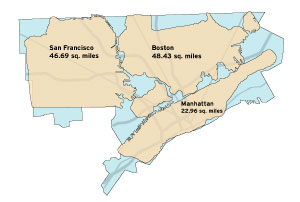
In Detroit, the statistics are jarring: The city has 26 jobs for every 100 people, 47 percent of residents are functionally illiterate, and, with 344 homicides in 2011, its violent-crime rate eclipses that of any other major U.S. city. Twenty-three percent of the housing stock is vacant, and though municipal tax rates in Detroit are 2.5 times the national average, services are spread thinly across the city’s expansive 143-square-mile footprint. As industry left town in the second half of the 20th century, the population declined steeply, leaving a city of 700,000 people to foot the bill for infrastructure designed for 2 million. The shrinking tax base, intensified by the recession and rampant foreclosures, left Detroit broke and scrambling to fend off a state takeover earlier this year.
 |
| Image © Dan Pitera Three urban areas easily fit inside Detroit’s vast footprint. The city’s shrinking population has struggled to support high-vacancy neighborhoods. View larger image. |
In 2010, Mayor Dave Bing, a basketball legend turned businessman, launched the latest effort to bring the city back from the brink. Branded the Detroit Works Project, the initiative was funded primarily by private organizations—including $2.7 million from the Kresge Foundation—to inventory the city’s physical condition and economic, social, and infrastructural challenges. “Detroit is unique because of its scale and size. There really isn’t a postindustrial American city with that level of vacancy and population loss,” says Toni Griffin, an urban-planning professor at City College of New York who was tapped by Detroit Works to oversee a team of economists, designers, planners, and engineers. Detroit Works will complete its final report in late October with a series of targeted recommendations for short- and long-term renewal.
The city has a troubled history with top-down planning projects that did more harm than good, and Bing and Detroit Works came under fire in the project’s early stages for lack of community engagement. In response, the group created a full-time staff to lead community meetings, focus groups, and other outreach efforts. They spent over 10 months floating ideas and soliciting feedback from philanthropies, businesses, city officials, and upwards of 75,000 community members.
When the Detroit Works report rolls out, it will propose immediate pilot projects generated through the public feedback. The plan hinges on leveraging and expanding the city’s existing programs, according to Dan Kinkead, an architect at Detroit-based Hamilton Anderson who leads the technical team along with Griffin. Examples include the nonprofit Focus: HOPE in northwest Detroit, which provides job training for adults and academic support for students; the Warm Training Center, which offers classes in green infrastructure and technology; and Hatch Detroit, a group that offers start-up capital and microgrants to small-scale entrepreneurs.
The planners hope that these will build momentum for larger initiatives like massive expansion of public transit and changing zoning codes to encourage denser neighborhoods, new business districts, and urban agriculture. Detroit Works will suggest coordinating the various agencies that now separately manage the city’s vacant land, says Kinkead. It will also recommend expanding programs that advocate reuse of blighted structures, rather than demolition, and addressing water contamination by diverting water from pipes to surface-level drainage.
The recommendations are ambitious for a city that has seen ineffectual master plans come and go, but Detroit Works has taken steps to have its recommendations carried out. In particular, it has gotten key players—city government, philanthropies, businesses, and corporate investors—to pledge financial or programmatic support. For its part, the Kresge Foundation says the recommendations will represent a significant slice of its grants for the next five to 10 years, and possibly beyond. “We’re already starting to concentrate our investments,” says Laura Trudeau, the foundation’s senior program director for community development, adding that the plan calls for expanding infrastructure projects of the last decade, which included $35 million for a 3.4-mile light rail in 2009 and $50 million for the Detroit RiverWalk starting in 2002.
This integrated approach is key to the new initiative. “Detroit’s assets are really there; they just have to be aligned and amplified,” Griffin says. Having obtained the support of the city’s financial, municipal, and community leaders, Griffin believes that Detroit Works will succeed where others failed.


Post a comment to this article
Report Abusive Comment